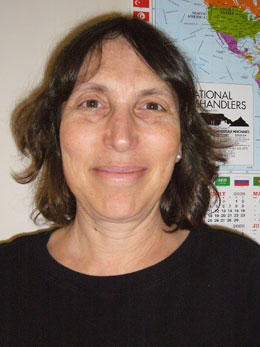Lisa Levin

Main content
Meet Lisa Levin, Scripps Institute of Oceanography, San Diego, USA
text and photos by Courtney Flanagan
As a schoolgirl by the sea in Los Angeles, California Lisa Levin joined a summer course in oceanography, she had good and inspiring teachers of biology in school, and then she couldn't be anything else than a oceanographer. She is now working with deep sea ecology and she's joining this cruice because she was invited by Chris (Schandler) who has been a cooperator since they met in Alaska 10 years ago. It would really have been better for her to join the 3.leg of this cruise, because she is working mostly with the ecology around the methane seeps, but tha was not suitable for her family and other plans. She has been working with methane seeps for about 15 years, and is still travelling around the world to recover and examine new ones. Her job has been in Peru, Chile, New Zealand, India and of course many places along the Pacific coast of USA. Here are many methane seeps where the kontinental shelf ends, and therefore have been sediments for a long time.
On this cruise she has been working in the group of macrobiologists together with Christoffer Schander, Andrey Gebruk og Joar Tverberg, a well functioning team. Lisa has been consentrated on the composition of species, trying to see a food web around the hydrothermal vents. It was hard to quantify the species, but she can say who eats who by studying the content of the stabile isotopes carbon, nitrogen and sulfur in the organisms. By measuring the quantity of these isotopes in bacterias/plankton and the animals higher up in the food chain, one can say something about the way they go from the bottom to the top. It's also possible to say if the energy comes from the photosynthesis or the chemosynthesis (iron, sulfur or methane).
Usually she finds a lot of different species in the sediments around the methane seeps, like worms, amphipoda, snails and clams. On this cruise she has also found them around the hydrothermal vents. Close to the vents they found mats of bacterias but no higher animals, because of the high content of CO2 and low content of oxygen in the sediments. It was a bit surprising, but they also have the same phenomena in i.e. The Indian Ocean, where there are methane seeps. Otherwise they found areas with a lot of sea anemones, medusaheads and other animals; an imposing sight! They also found some new species, but they are left for Chris to determine, she consentrates on the diversity.
Lisa has a lot of plans for the future; in the autumn she is going to The Indian Ocean, and next year to Costa Rica to examine the life around the methane seeps. She thinks that there still are some seeps to be discovered, and maybe they can be a great resourse of energy in the future. It's found huge deposits of "methane ice" (gas hydrate) 800 meters below the sea bottom, which the japanese have been thinking of exploiting. It will be very expensive, and the methane should not evaporate into the atmosphere and cause green house effect. Lisa thinks that in the futue there will be some oseanographic research connected to the global warming. There will probably also be important to study the metals in the hydrothermal vents, thinking of exploitation. Some commercial interests are already working with that, i.e. in Papua New Guinea.
Lisa likes very much to join research cruises, because then she meets good collegues from all over the world, whith whom she can cooperate and exchange experiences with. She would very much like to come to Norway again, to work with Chris and his group in Bergen.
